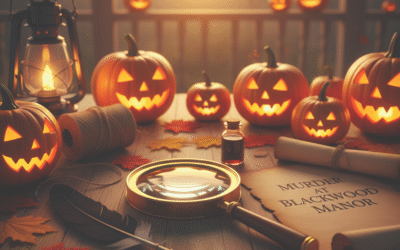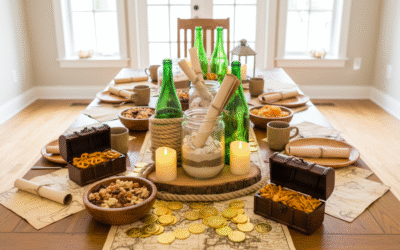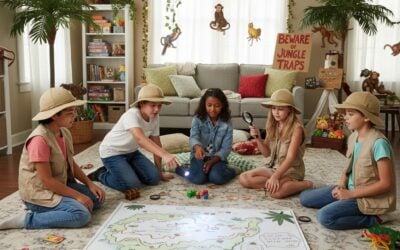Set the Scene for Suspense
A murder mystery party without a proper crime scene is like a train without a track—it’s going nowhere fast. The setting is more than just a backdrop; it’s the silent character that whispers, “Something terrible happened here… and you might be next.” The good news? You don’t need a movie set budget to create an immersive space. With smart atmosphere choices, thoughtful layout, and strategic lighting, you can turn any room—living room, garage, classroom—into a space that makes your guests forget they’re only pretending to solve a crime.
Step 1: Choose Your Crime Scene Style
The first thing to decide is what kind of scene your guests will walk into. A 1930s luxury train murder feels very different from a jungle expedition gone wrong. Pick a style that fits your chosen mystery, then carry that style through every design choice. If you’re hosting a Murder on the Orient Express-inspired event, think plush fabrics, brass accents, and vintage travel posters. A Wild West saloon scene? Dusty tables, lanterns, and an upright piano (real or cardboard) in the corner.
The goal is consistency. Even a small room can feel immersive if every detail is pulling in the same direction.
Step 2: Build Atmosphere with Layers
Atmosphere is more than props—it’s the combination of sight, sound, scent, and even touch.
Sight: Start with big visual cues: a chalk outline, “Police Line Do Not Cross” tape, or themed wall backdrops. Layer in smaller details like scattered “clues” (fake evidence bags, printed suspect lists, maps). If your mystery involves travel, display suitcases, ticket stubs, and vintage luggage tags.
Sound: Play a looped background track that matches your setting. A train’s steady clatter, jungle noises, or a scratchy gramophone recording can work wonders.
Scent: Subtle scents can anchor the setting in your guests’ minds. Think cedarwood or leather for a study, citrus and floral for a train’s dining car, or earthy wood notes for a jungle base camp.
Touch: Let guests handle certain props—letters, old books, or “evidence”—to keep them engaged beyond sight and sound.
Step 3: Plan Your Layout Like a Stage
Your room is the stage, and your guests are both actors and audience. Arrange the space to encourage movement, interaction, and suspense.
– Entry Point: Give guests a striking first impression when they arrive—like stepping through a curtain into the main room or passing a “ticket inspection” table.
– Central Action Zone: Reserve space for big reveals, reading clues aloud, or confronting suspects.
– Evidence Corners: Dedicate small areas for “found” objects—label them with scene markers so guests can study them without disturbing the layout.
– Movement Paths: Arrange furniture to create natural flow. People should have to walk past certain props or through certain zones to get from point A to point B.
Step 4: Master Lighting for Drama
Lighting is the quickest way to shift a space from ordinary to ominous. It can also hide a multitude of decorating shortcuts.
– Low & Focused: Dim overhead lights and rely on table lamps, string lights, or LED candles. This creates cozy pockets of light where guests naturally gather.
– Colored Light Accents: Use inexpensive LED bulbs to cast subtle reds, blues, or golds—just enough to tint the scene.
– Spotlight Clues: Place a small clip-on light or flashlight beam toward a piece of evidence to draw attention.
– Shadow Play: Position lamps behind props to cast dramatic, elongated shadows for extra intrigue.
For bonus atmosphere, sync lighting changes with major game moments—plunging the room into darkness right before a “murder” is revealed never gets old.
Step 5: Integrate Clues into the Decor
Why hand out all your evidence on index cards when you can weave it into the room itself? Slip coded messages into picture frames, leave lipstick-stained glasses on a side table, or scatter torn map pieces under a chair. Guests will feel like detectives making real discoveries instead of just reading prompts.
Pro tip: Plant both real and red herring clues in the space. That way, players will have to work to separate meaningful evidence from background “noise.”
Step 6: Keep It Practical
While immersion is the goal, remember your guests need to move, mingle, and see each other’s expressions. Avoid overcrowding the space with props that block movement. Keep food and drink stations accessible and away from fragile evidence displays. And if your game involves writing down notes or guesses, make sure there’s enough light in certain zones for guests to read.
Step 7: Scale for Your Space
Big spaces can feel empty without enough detail; small spaces can feel cramped if you overdo it. In a living room, focus on key walls and table setups. In a large hall, create multiple “scenes” that guests can explore during the game. Remember: your atmosphere doesn’t have to fill every inch—just enough to make guests feel they’ve stepped into another world.
Step 8: Elevate with Personal Touches
Use your guest list as inspiration for little details. If you know someone is playing an archaeologist, make sure a dusty artifact is sitting in “their” corner. Hosting a mix of adults and kids? Scatter some lighthearted props among the serious clues to keep younger players engaged without breaking the overall tone.
Step 9: Reveal and Reset
Plan for your room to evolve during the game. Start with a pristine setup, then let the space get “messed up” as players find clues and accuse each other. By the time you hit the final reveal, the crime scene should look like it’s been actively investigated—papers askew, evidence bags opened, maybe even a chair knocked over for dramatic effect.
The Payoff
When you take the time to build atmosphere, layout, and lighting into your murder mystery party, you’re not just decorating—you’re crafting an experience. Guests will remember the mood you created long after they’ve forgotten who had the winning guess. And if you’re running one of our printable mysteries, the right setting can take your game from “fun” to “I can’t believe you pulled that off in your living room.”
In short: control the space, control the mood, and you control the story.




0 Comments